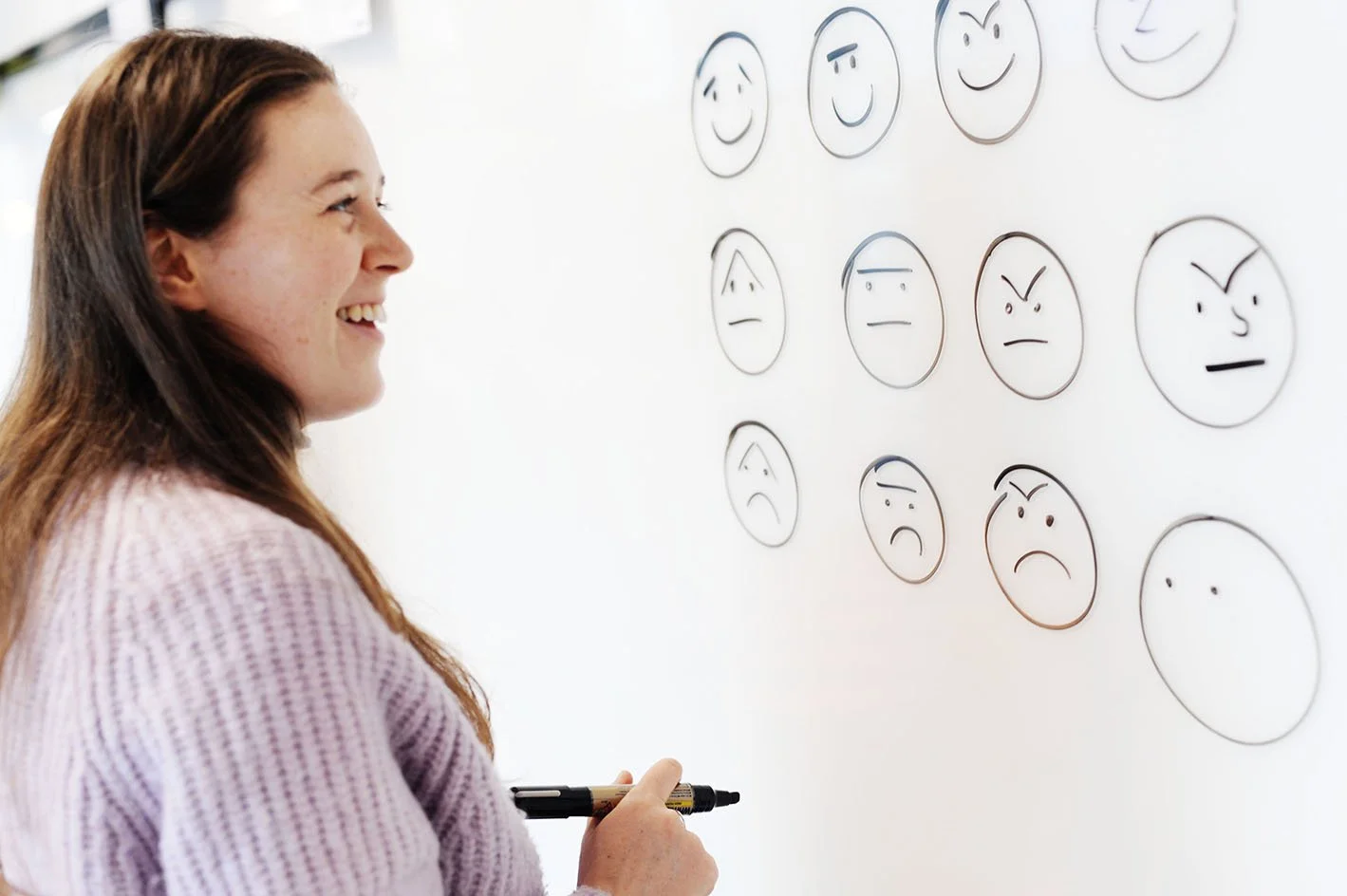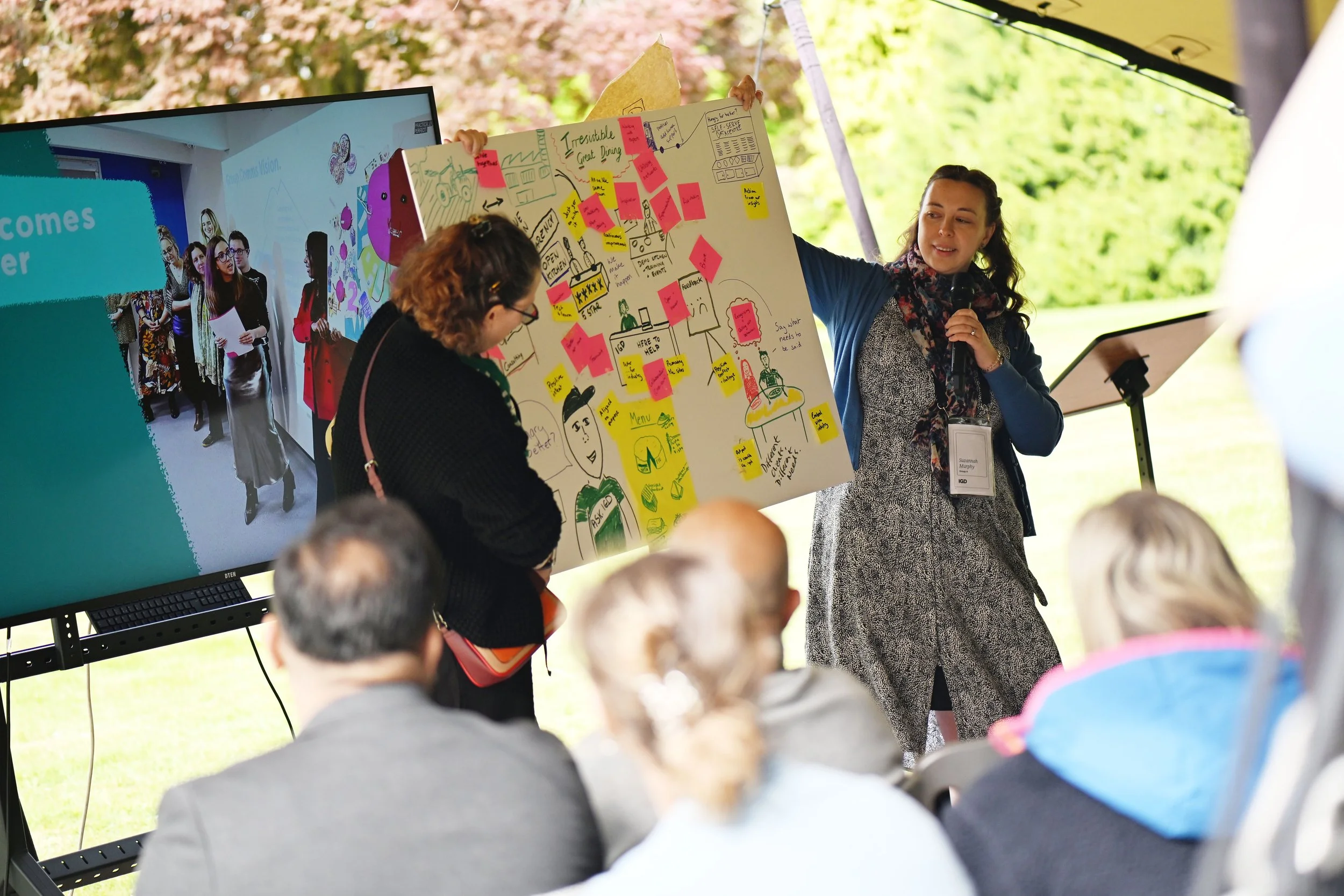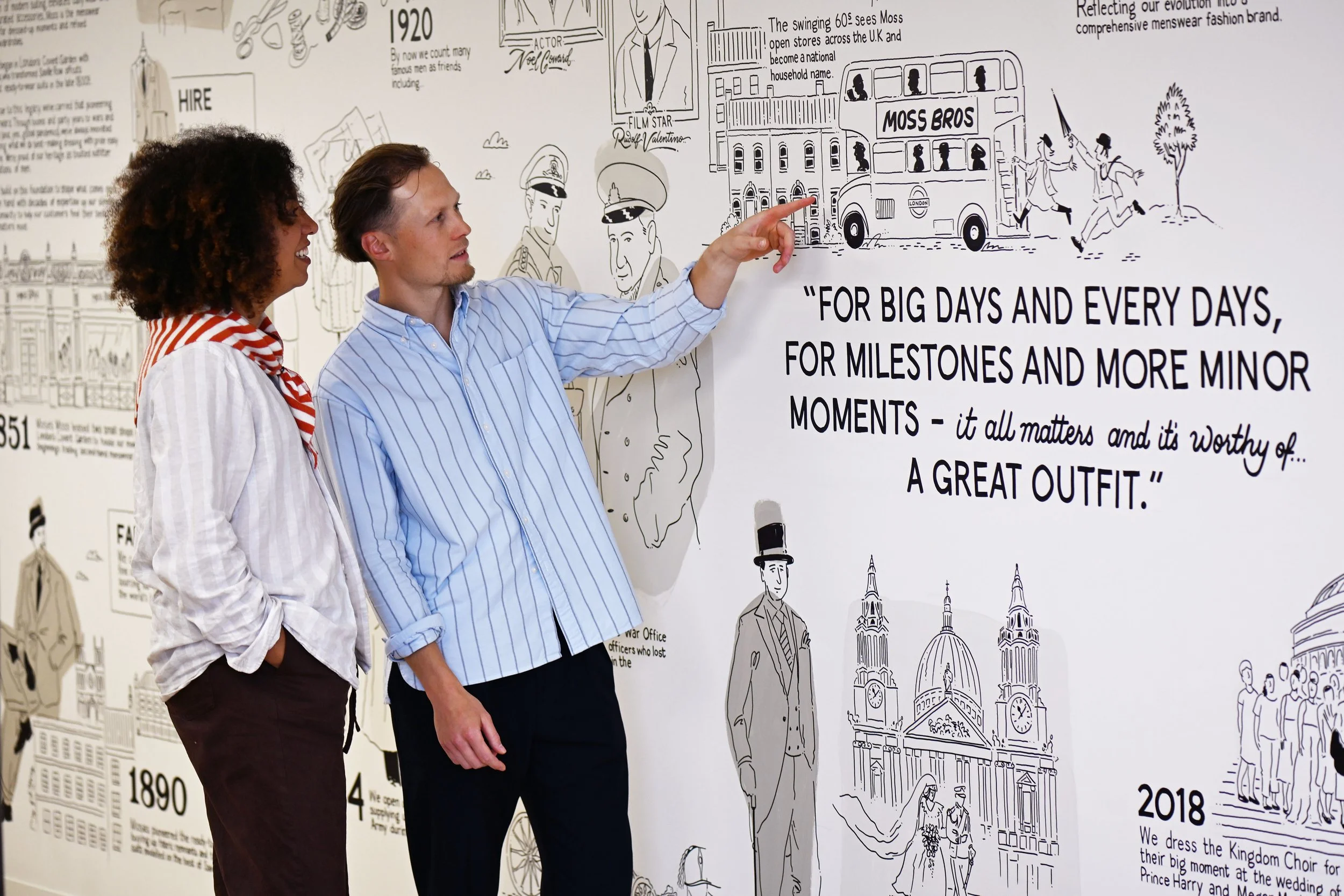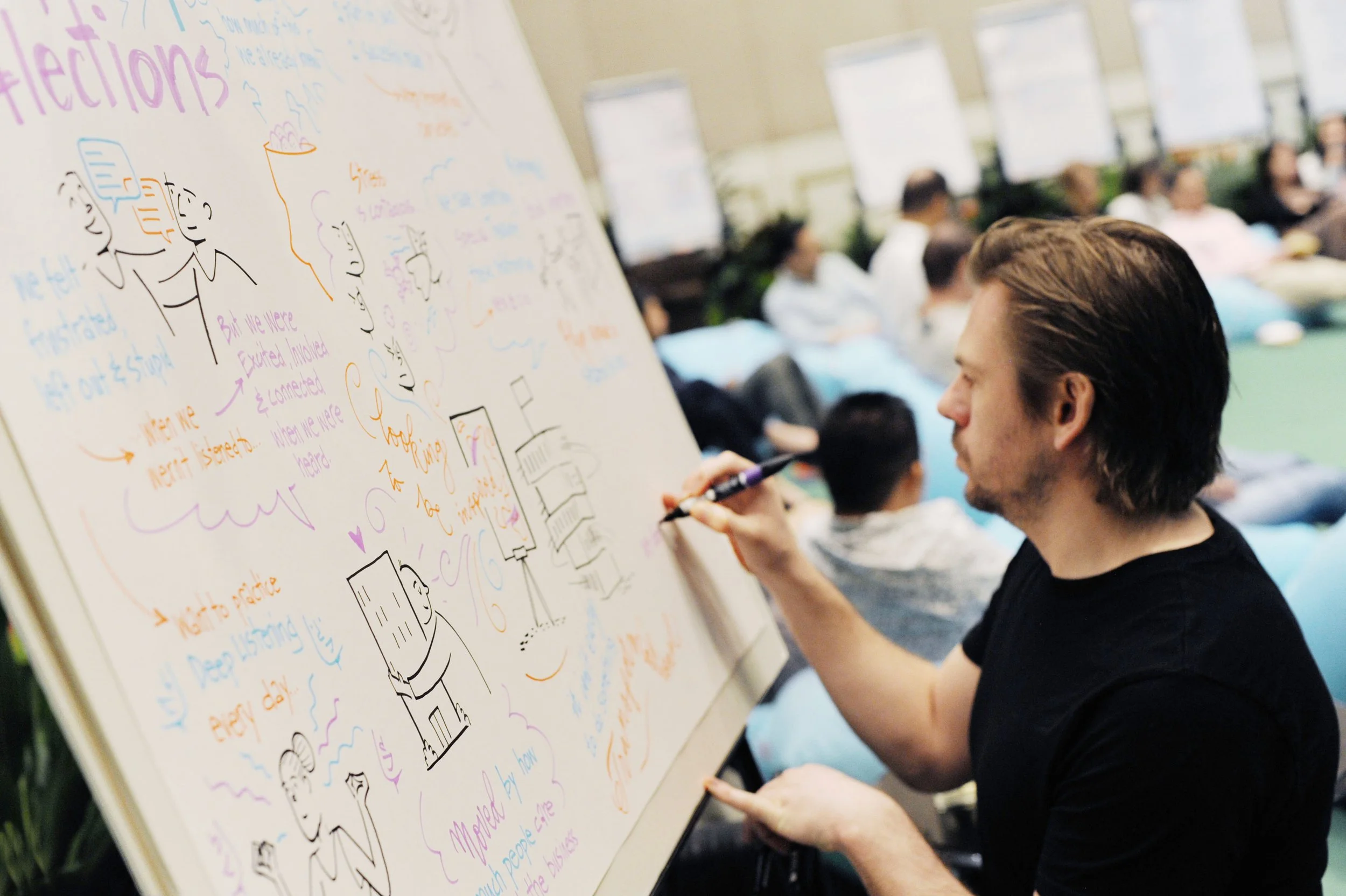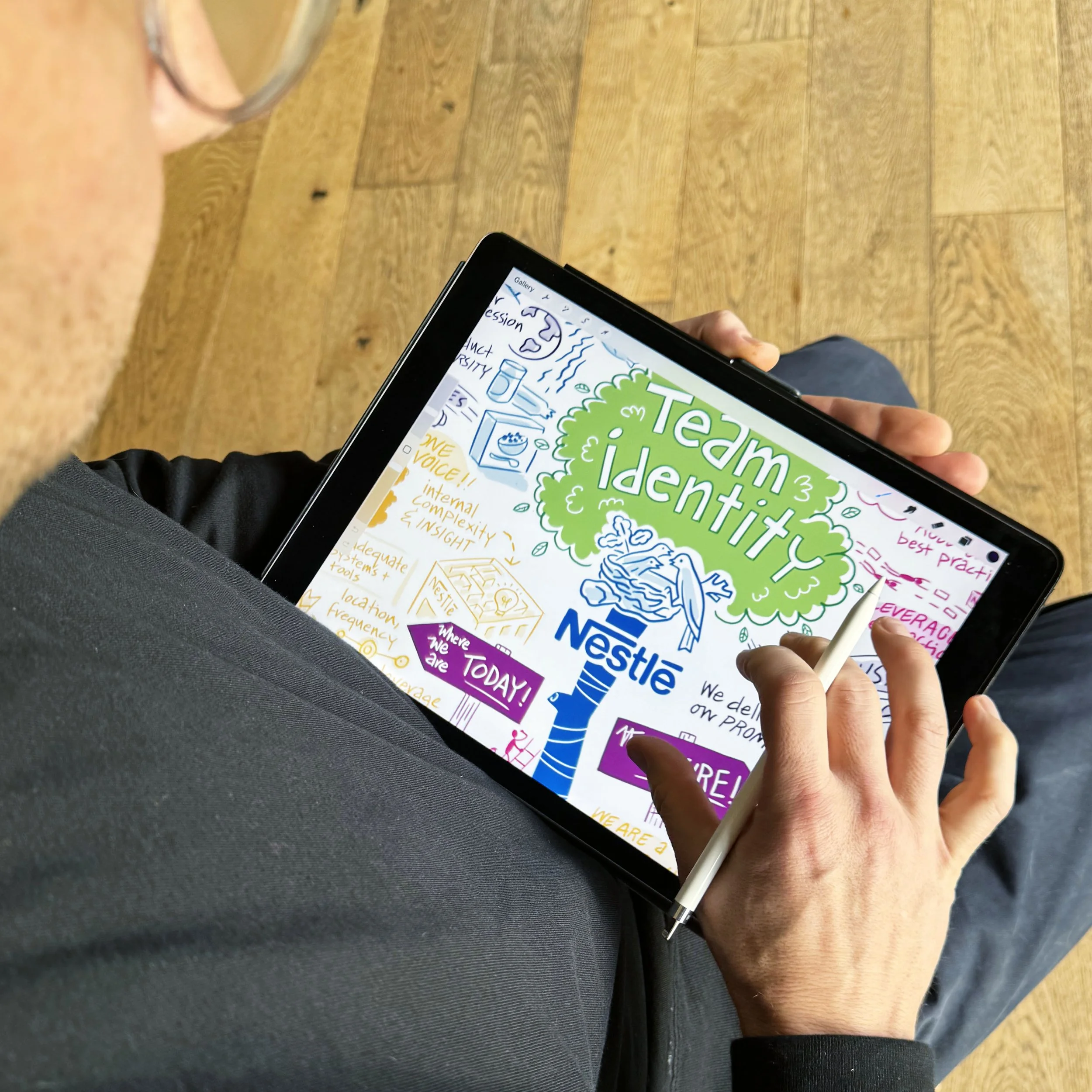What is Visual Thinking, and why is it important for businesses today?
How can Visual Thinking solve problems?
Visual Thinking helps teams align around strategies, visions or change programmes by creating a shared picture of the truth. It improves engagement and breaks down siloed communication by giving individuals and groups a visual voice and sense of ownership. It is especially effective when organisations struggle to communicate complex ideas to stakeholders.
Who typically benefits most from working with a Visual Thinking agency?
Any organisation undergoing transformation or change can benefit from Visual Thinking. Leadership teams use it to communicate vision and direction more clearly. HR and internal communications departments often apply it when rolling out culture or engagement initiatives. Innovation and strategy managers also find it useful for making complex roadmaps more digestible and easier to communicate.
What is live scribing, and how does it work?
Live scribing is the real-time visual capture of discussions, workshops or conferences. An artist listens closely, distils key themes and draws them onto large boards or digital canvases as the session unfolds. This creates a dynamic visual record that participants can reflect on immediately, helping to enhance engagement and improve memory retention.
How do visuals support strategy and innovation?
Visuals turn complex strategic plans into clear, easy-to-follow roadmaps. They allow stakeholders to visualise the future in a tangible way and support brainstorming and idea generation using visual frameworks. By doing so, they foster alignment and a greater sense of ownership across teams.
How do you ensure the visuals resonate with the client’s culture?
To ensure visuals feel authentic, we pay attention to tone of voice and representation of diversity. Client teams are involved early in the sketching process, and familiar language, metaphors and brand elements are incorporated. Drafts are tested with a variety of stakeholders to ensure they align with organisational identity while balancing creativity with the appropriate tone.
Are these visuals just “nice to have” or do they drive real results?
Visuals deliver measurable impact by improving comprehension, alignment and engagement across teams. They shorten the time it takes to explain strategies and significantly increase recall compared to text-heavy presentations. Because visuals create clarity and a sense of ownership, they also help drive action and momentum.
What are common misconceptions about Visual Thinking?
A common misconception is that visual thinking is simply drawing, when in fact it is a structured method of problem-solving. Another misconception is that it only applies to creative industries, whereas it is widely used across sectors such as finance, healthcare, government and technology. It is often mistaken as childish, yet visuals can unlock highly strategic and meaningful conversations. It is also not an unnecessary expense but a tool that creates serious business impact.
Visual Thinking is the practice of using imagery, diagrams and visual tools to make complex ideas easier to understand. It enables teams to see connections and patterns more clearly than text alone can’t provide. By turning big ideas and abstract concepts into tangible visuals, it helps reduce miscommunication and ensures shared understanding. In a world overwhelmed with information, visuals are processed much more quickly and retained for longer, making them a critical tool for modern organisations.
How does a Visual Thinking agency differ from a traditional creative agency or strategic consultancy?
Traditional agencies typically focus on marketing outputs such as branding, campaigns and advertising materials. Visual Thinking agencies instead centre their work on achieving clarity of communication within organisations. They use visuals to support strategy, innovation, culture change and storytelling, placing less emphasis on selling a product and more on aligning people around shared goals.
What formats can Visual Thinking take?
Visual Thinking can be expressed as anything from a small vignette to a large body of content. We offer a suite of services that intersect with one another through our Discover, Design, Develop, Deliver approach. We like to start with a Creative Working Session, that can include live scribing. However this can stand alone at other events and workshops. Our range of services include Rich Pictures, Infographics, large-scale Murals, and Animations.
How do you approach a new project with a client?
Every project begins with an initial conversation to understand the client’s needs. This is followed by our Discovery (or scoping sessions) to explore challenges, ask questions around the what, why, how, who and when, and capture key language and ideas.
Our process is designed to be interactive and iterative, involving sketching, refinement and finalisation. The final assets are created to live beyond a single moment and can be delivered in both digital and physical formats, always thinking about what comes next!
Do you only work in person, or can you work virtually too?
Visual thinking can be delivered in person, virtually or through a hybrid approach. Digital scribing works seamlessly in platforms such as Zoom and Teams, and remote collaboration tools enable sketching, feedback and iterations online. This flexibility allows us to support our clients globally without the constraints of travel.
How long does a typical project take?
Timeframes vary depending on the complexity and stakeholder involvement. Live event scribing is delivered instantly, but may take weeks even months of planning. A Rich Picture or infographic usually takes two to three weeks, while larger pieces such as murals can take a couple of months to plan. However, we like to establish timeframes early on. We will suggest an approach that works for you to ensure you have something that delivers with the greatest impact within the time and budget available.
How do you measure the impact of Visual Thinking work?
Impact can be measured through post-project surveys that assess clarity and alignment, as well as engagement metrics such as downloads, shares and reuse of digital assets. Feedback from leadership teams and workshop participants also provides valuable insight. Longer-term impact can be seen in how visuals become embedded in daily communication and culture.
How can an organisation get started with a Visual Thinking project?
The best way to begin is by having a conversation with us! You may think you have an unsolvable challenge - but we can assure you are in experienced hands.
A great way to begin is with one of our Discovery sessions. We understand the current challenges you are facing and what success looks likes. This is can be done as a remote call, or an in-person facilitated working session.
Next is the Design Phase. This is designed to gather crucial perspectives, foster trust, and to provide leadership insight into your people’s needs and requirements. We will begin to draft out what your Visual Storytelling will look like.
Once we have alignment as a group. We bring everything together in the Develop phase; and begin crafting the story, having identified the channels we have available to use.
Finally, Our creative team works with you to Deliver the assets at key milestones to your timeframes.

